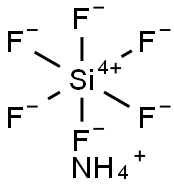Ammonium hexafluorosilicate is a white crystalline
powder. Odorless.
Poison by ingestion and
subcutaneous routes. See also
diHYDROGEN and FLUORIDES. When
heated to decomposition it emits very toxic
fumes of F-, NH3,
This material is used as a pesticide
and miticide, wood preservative, soldering flux; light metal
casting; and in the etching of glass.
UN2856 Fluorosilicates, n.o.s., Hazard Class:
6.1; Labels: 6.1-Poisonous materials, Technical Name
Required.
Aqueous solution is highly corrosive.
Contact with acids reacts to form hydrogen fluoride,
which is a highly corrosive and forms a toxic gas.
Corrosive to aluminum. Incompatible with oxidizers (chlorates,
nitrates, peroxides, permanganates, perchlorates,
chlorine, bromine, fluorine, etc.); contact may cause fires
or explosions. Keep away from alkaline materials, strong
bases, strong acids, oxoacids, epoxides. Ammonium fluorosilicate
reacts with water to form
hydrofluoric acid, a source of fluoride ions. Unlike other
halide ions, the fluoride ion is highly reactive, acting as a
weak base and participating in some unique reactions. In
particular, fluorides react strongly with compounds containing
calcium, magnesium, or silicon ions, which means
that solutions containing soluble fluorides are corrosive to
both living tissue and glass. Hydrofluoric acid can cause
severe chemical burns and is one of the few materials that
can etch glass. It is also a toxic gas in its anhydrous
form.
Consult with environmental
regulatory agencies for guidance on acceptable disposal
practices. Generators of waste containing this contaminant
(≥100 kg/mo) must conform with EPA regulations governing
storage, transportation, treatment, and waste disposal.
Incineration.
